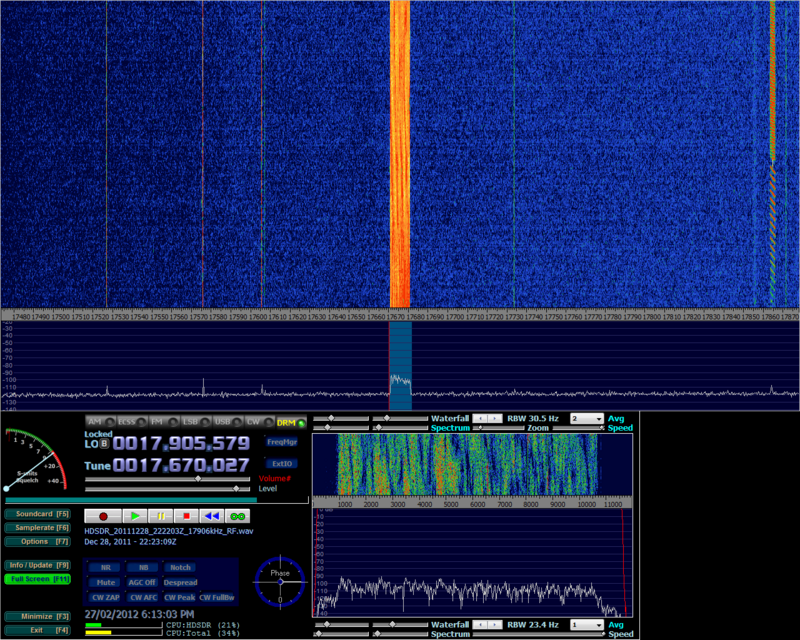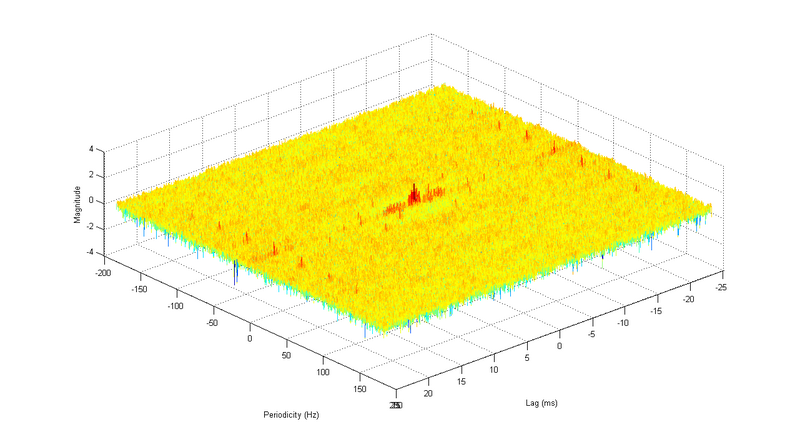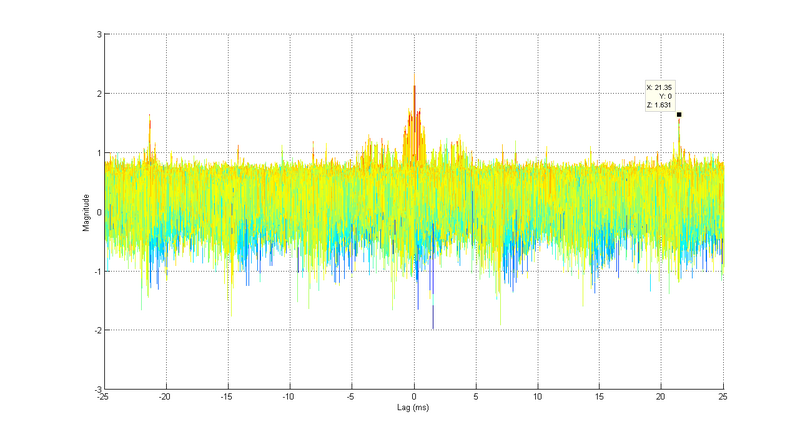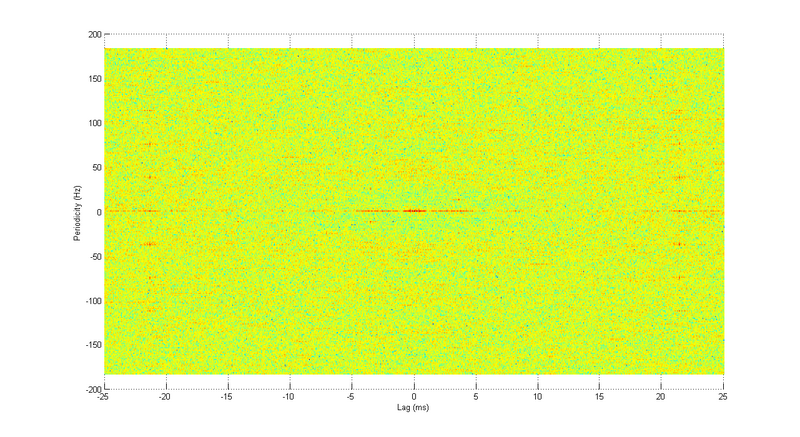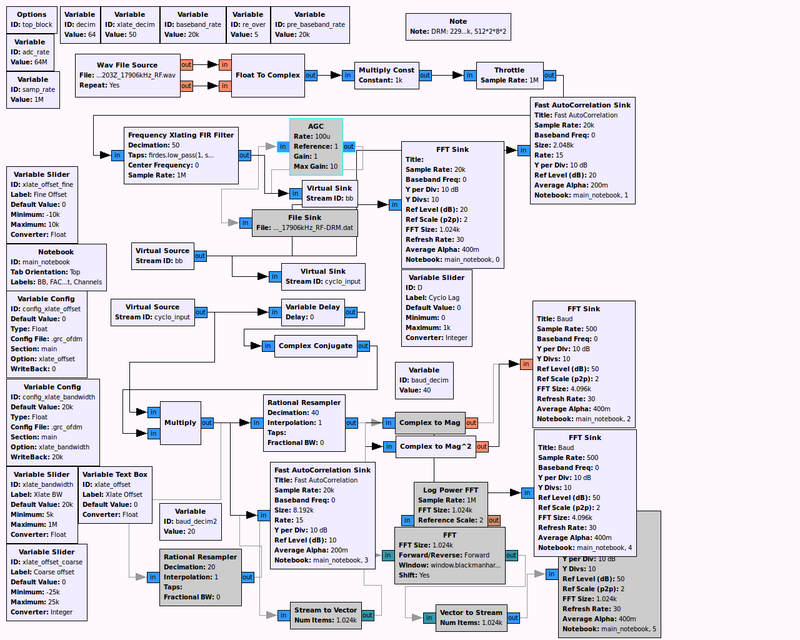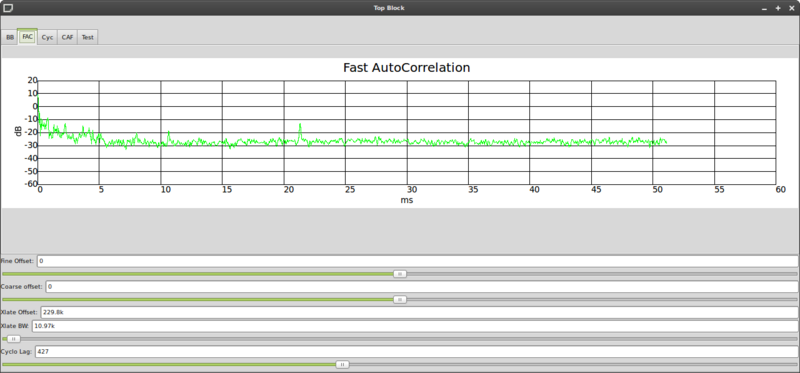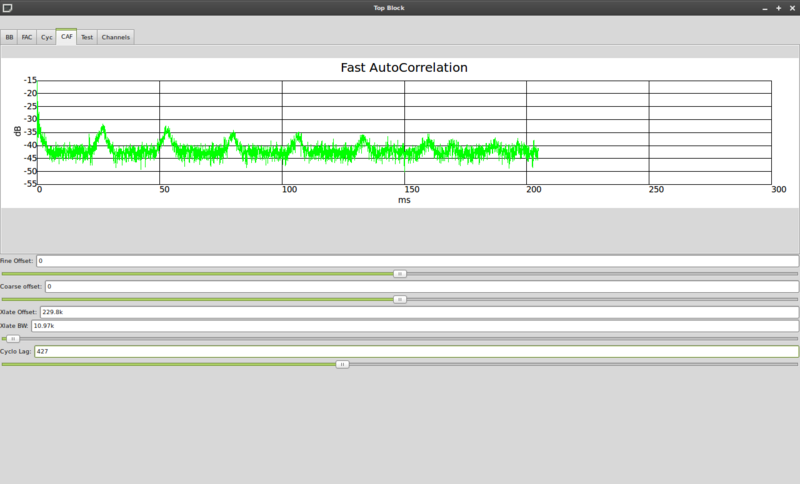OFDM
Contents
General
- DVB-T Crest factor is greater than 8VSB (one reason why it wasn't adopted in the US).
Blind Analysis
- Ning Han, Sung Sohn, Jae Moung, "A Blind OFDM Detection and Identification Method Based on Cyclostationarity for Cognitive Radio Application", IEICE Transactions on Communications, Volume E92-B, Number 6, pp. 2235-2238, June 2009.
- Find sub-carrier spacing and duration of guard interval.
- Exploit cyclic prefix and cyclostationarity of OFDM due to transmitter pulse-shaping filter.
DRM
Most common on HF is:
| Modulation property | Value |
|---|---|
| Un-guarded symbol time | 21.33 ms |
| Sub-carrier spacing | 46 7/8 Hz |
| Guard interval | 5.33 ms |
| Total symbol duration | 26.66 ms |
| Guard interval ratio | 1/4 |
| Symbols per frame | 15 |
After capturing a DRM signal from Radio New Zealand International (above) and calculating the Cyclic Autocorrelation Function (CAF), it is confirmed to be class B:
The guard interval is the difference between the total symbol duration and the un-guarded symbol time. The sub-carrier spacing is the inverse of the un-guarded symbol time.
MATLAB
One can define a CAF calculation function like so (to do it properly you would use variable arguments, etc):
function [c,lag_labels,period_labels] = caf(x,start,len,tau,step,fft_range)
decim = 1;
len = len * decim;
if (tau > start)
error('tau > start');
elseif ((start + tau + len) > length(x))
error('length error')
end
c = [];
x_labels = [];
if fft_range > 0
mid = fft_range;
else
mid = floor(len/decim/2);
end
period_labels = (-mid:mid)';
for n = -tau:step:tau
% Progress for long signals
%if length(x) > (16384*2)
% disp(n);
%end
%n
% If you want to zero-pad the signal
%if n < 0
% t = cat(1, zeros(-n, 1), x(1:end+n));
%elseif n > 0
% t = cat(1, x(n+1:end), zeros(n, 1));
%else
% t = x
%end
t = x(start-n:start-n+len-1);
%length(t)
z = x(start:start+len-1).*conj(t);
if decim > 1
z = resample(z, 1, decim);
end
f = log10(abs(fftshift(fft(z))));
%length(f)
if fft_range > 0
mid = floor(length(f)/2)+1;
f = f(mid-fft_range:mid+fft_range);
end
c = cat(2, c, f);
lag_labels = cat(1, x_labels, [n]);
end
end
Then you would take the following steps to analyse a signal:
% This function can be found in an m file in the GNU Radio source tree
x = read_complex_binary('DRM.dat');
% Calculate the CAF (refer to function above):
[c,x_lab,y_lab] = caf(x,500000,16384, 500, 1, 150);
% Finally graph the CAF (and zoom in to show the peaks of interest):
mesh(x_lab*(1/20),(y_lab*(20000/16384)),c);
Analysis in GNU Radio
One can use GRC (GNU Radio Companion) to construct something like this:
Run signal through Fast Auto-correlation to find un-guarded symbol duration. Set cyclo-lag to this value in samples (i.e. change Variable Delay at runtime). Run cyclo'd signal through another Fast Auto-correlation to find total symbol duration (including guard interval) - this is an FFT for (or a 'line' cut out of) one lag in the CAF above.
Generating the cyclo'd signal simply involves multiplying the signal by a delayed (lagged) version of itself. A new 'Variable Delay' block for GRC allows changing the delay (number of samples) during runtime.
OFDM Mod GRC block
packet_mod_X(ofdm_mod(<options>)) - argument is 'packet_source'
packet_mod:
grc/grc_gnuradio/blks2/packet.py
packet_utils:
<core>/python/gnuradio/packet_utils.py
packet_mod_X
- Default payload: 512 bytes (if supplied length is default 0, must be multiple of input stream size)
- Input signature: X
- Output signature: inherited from 'packet_source' stream #0 (complex for ofdm)
Starts packet encoder thread that packages incoming data into payload size and submits to 'packet_source' via 'send_pkt' call.
packet_utils.make_packet: preamble, access code, length of payload and CRC, (optionally whitened) payload with CRC-32, end byte.
- 'preamble' is fixed.
- 'access code' can be left as default (customisable preamble)
ofdm_mod:
<core>/python/gnuradio/blks2impl/ofdm.py
_pkt_input (ofdm_mapper_bcv) -> preambles (ofdm_insert_preamble) -> ifft (fft_vcc) -> cp_adder (ofdm_cyclic prefixer) -> scale (multiply_const_cc)
Padded preamble generation (for correlation in time domain):
- zeros_on_left = ceil((FFT length - occupied tones) / 2.0)
- ksfreq = take 'occupied symbols' length from known_symbols_4512_3 (randomly generated fixed list of 1/-1, 4512 items long (=4000+512 ?))
- Each item (offset by zeros_on_left) that has an odd index is zeroed.
- Padded preamble is FFT length, with zeros_on_left, then ksfreq hardcoded symbols, then remaining zeros on right.
ofdm_mapper_bcv: constellation based on modulation, message queue limit (default: 2), occupied tones, FFT length
ofdm_insert_preamble (insert 'pre-modulated' preamble symbols before each payload): FFT length, padded preambles
ofdm_cyclic prefixer (prefix output with CP length from end of input symbols): FFT length, symbol length (= FFT length + cyclic prefix length)
multiply_const_cc: 1.0 / sqrt(FFT length)
| ||||||||||||||||||||||||||||||||||||||||||||||||||||||||||||||||
